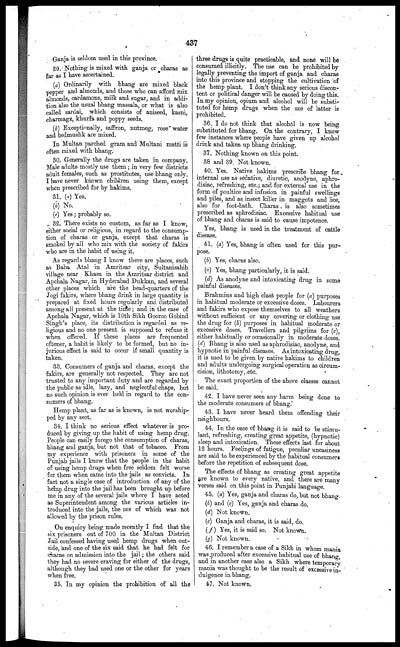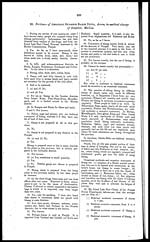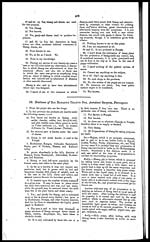Medicine - Drugs > Report of the Indian Hemp Drugs Commission, 1894-1895 > Volume V
(457) Page 437
Download files
Individual page:
Thumbnail gallery: Grid view | List view

437
Ganja is seldom used in this province.
29. Nothing is mixed with ganja or charas as
far as I have ascertained.
(a) Ordinarily with bhang are mixed black
pepper and almonds, and those who can afford mix
almonds, cardamons, milk and sugar, and in addi-
tion also the usual bhang massala, or what is also
called sardai, which consists of aniseed, kasni,
charmagz, khurfa and poppy seeds.
(b) Exceptionally, saffron, nutmeg, rose* water
and bedmushk are mixed.
In Multan parched gram and Multani matti is
often mixed with bhang.
30. Generally the drugs are taken in company.
Male adults mostly use them ; in very few districts
adult females, such as prostitutes, use bhang only.
I have never known children using them, except
when prescribed for by hakims.
31. (a) Yes.
(b) No.
(c) Yes; probably so.
32. There exists no custom, as far as I know,
either social or religious, in regard to the consump-
tion of charas or ganja, except that charas is
smoked by all who mix with the society of fakirs
who are in the habit of using it.
As regards bhang I know there are places, such
as Baba Atal in Amritsar city, Sultanisahib
village near Khasa in the Amritsar district and
Apchala Nagar, in Hyderabad Dukkan, and several
other places which are the head-quarters of the
Jogi fakirs, where bhang drink in large quantity is
prepared at fixed hours regularly and distributed
among all present at the time ; and in the case of
Apchala Nagar, which is 10th Sikh Gooroo Gobind
Singh's place, its distribution is regarded as re-
ligious and no one present is supposed to refuse it
when offered. If these places are frequented
oftener, a habit is likely to be formed, but no in-
jurious effect is said to occur if small quantity is
taken.
33. Consumers of ganja and charas, except the
fakirs, are generally not respected. They are not
trusted to any important duty and are regarded by
the public as idle, lazy, and neglectful chaps, but
no such opinion is ever held in regard to the con-
sumers of bhang.
Hemp plant, as far as is known, is not worship-
ped by any sect.
34. I think no serious effect whatever is pro-
duced by giving up the habit of using hemp drug.
People can easily forego the consumption of charas,
bhang and ganja, but not that of tobacco. From
my experience with prisoners in some of the
Punjab jails I know that the people in the habit
of using hemp drugs when free seldom felt worse
for them when came into the jails as convicts. In
fact not a single case of introduction of any of the
hemp drug into the jail has been brought up before
me in any of the several jails where I have acted
as Superintendent among the various articles in-
troduced into the jails, the use of which was not
allowed by the prison rules.
On enquiry being made recently I find that the
six prisoners out of 700 in the Multan District
Jail confessed having used hemp drugs when out-
side, and one of the six said that he had felt for
charas on admission into the jail ; the others said
they had no severe craving for either of the drugs,
although they had used one or the other for years
when free.
35. In my opinion the prohibition of all the
three drugs is quite practicable, and none will be
consumed illicitly. The use can be prohibited by
legally preventing the import of ganja ana charas
into this province and stopping the cultivation of
the hemp plant. I don't think any serious discon-
tent or political danger will be caused by doing this.
In my opinion, opium and alcohol will be substi-
tuted for hemp drugs when the use of latter is
prohibited.
36. I do not think that alcohol is now being
substituted for bhang. On the contrary, I know
few instances where people have given up alcohol
drink and taken up bhang drinking.
37. Nothing known on this point.
38 and 39. Not known.
40. Yes. Native hakims prescribe bhang for
internal use as sedative, diuretic, anodyne, aphro-
disiac, refreshing, etc.; and for external use in the
form of poultice and infusion in painful swellings
and piles, and as insect killer in maggots and lice,
also for foot-bath. Charas. is also sometimes
prescribed as aphrodisiac. Excessive habitual use
of bhang and charas is said to cause impotence.
Yes, bhang is used in the treatment of cattle
disease.
41. (a) Yes, bhang is often used for this pur-
pose.
(b) Yes, charas also.
(c) Yes, bhang particularly, it is said.
(d) As anodyne and intoxicating drug in some
painful diseases.
Brahmins and high class people for (a) purposes
in habitual moderate or excessive doses. Labourers
and fakirs who expose themselves to all weathers
without sufficient or any covering or clothing use
the drug for (b) purposes in habitual moderate or
excessive doses. Travellers and pilgrims for (c),
cither habitually or occasionally in moderate doses.
(d) Bhang is also used as aphrodisiac, anodyne, and
hypnotic in painful diseases. As intoxicating drug,
it is used to be given by native hakims to children
and adults undergoing surgical operation as circum-
cision, lithotomy, etc.
The exact proportion of the above classes cannot
be said.
42. I have never seen any harm being done to
the moderate consumers of bhang.
43. I have never heard them offending their
neighbours.
44. In the case of bhang it is said to be stimu-
lant, refreshing, creating great appetite, (hypnotic)
sleep and intoxication. These effects last for about
12 hours. Feelings of fatigue, peculiar uneasiness
are said to be experienced by the habitual consumers
before the repetition of subsequent dose.
The effects of bhang as creating great appetite
are known to every native, and there are many
verses said on this point in Punjabi language.
45. (a) Yes, ganja and charas do, but not bhang
(b) and (c) Yes, ganja and charas do.
(d) Not known.
(e) Ganja and charas, it is said, do.
(f) Yes, it is said so. Not known.
(g) Not known,
46. I remember a case of a Sikh in whom mania
was produced after excessive habitual use of bhang,
and in another case also a Sikh where temporary
mania was thought to be the result of excessive in-
dulgence in bhang.
47. Not known.
Set display mode to: Large image | Zoom image | Transcription
Images and transcriptions on this page, including medium image downloads, may be used under the Creative Commons Attribution 4.0 International Licence unless otherwise stated. ![]()
| India Papers > Medicine - Drugs > Report of the Indian Hemp Drugs Commission, 1894-1895 > Volume V > (457) Page 437 |
|---|
| Permanent URL | https://digital.nls.uk/75122219 |
|---|
| Description | Volume 5: Evidence of witnesses from North-Western Provinces and Oudh and Punjab. Answers from witnesses in North-Western Provinces, Oudh and Punjab about cultivation and growth of hemp, preparation or manufacture, trade, consumption or use, effects, administration - taxation and control. |
|---|---|
| Attribution and copyright: |
|




